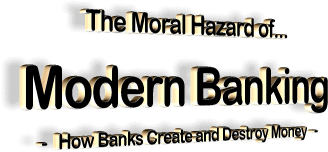|
by Robert Bonomo May 31, 2011 from TheCactusLand Website
by Quentin Metsys - 1466
Lloyd Blankfein
The major question raised was, would
this 'bailout' contagion infect the integrity of our economic and
political system? But far more interesting and much less discussed
are the mechanics of modern banking and their moral implications.
But where did all that money come from? The vast majority of people think that banks borrow money from the FED or depositors at one rate, lend it at another and make a spread.
This concept is completely false.
Banks create money, loan it out, make
their margin through compound interest, and destroy the same money
that they created as it is paid back.
Modern fiat money, the dollar, euro, yen
etc are all based on debt. For every dollar in existence, there is
somewhere an
IOU for the same amount. This is
best illustrated with an example of a typical mortgage.
The bank will ask Jack for a promissory note, an IOU, for the $100,000 and once he signs it, they open an account in which they create from nothing $100,000 for Jack in exchange for his IOU. That $100,000 is a liability for the bank, their asset is the IOU.
The bank just 'created' $100,000 which is backed by the good faith of Jack to pay it back as well as the deed to the house he bought.
Now the bank loans that money to Jack, with compound interest. The interest is the fee the bank charges for monetizing the debt. Jill would not have wanted an IOU from Jack for the 100K, so the bank did him the service of converting his IOU into dollars, and for this service they charge him interest.
As Jack pays down his mortgage
principal, the value of the IOU will be drawn down as well, until
all the money 'created' is destroyed, and the IOU is worthless.
Banks are restricted as to how much money they can create by the amount they have on reserve with the FED.
The formula is complex, but, for simplicities sake, it is around 10 times as much as they have on reserve, (actually more). If the bank has 1 million dollars on reserve with the FED, for which they are now paid interest, they can create and loan out about 10 million dollars.
Banks are paid for the privilege of
creating and leasing money. This is our modern, fractional reserve
banking system.
The typical return on residential real estate is about 5%, anything with a return of 10% would be snapped up in an instant. So how much do banks make when they loan their 'created' money out?
Let's assume Jack has been a good boy, and gets a fixed rate loan of 5% on his $100,000 mortgage for a period of 10 years. The bank is obligated to leave $10,000 in reserve, or 10% of the amount loaned out, but they do not give up the money, and they are now paid interest on it, so the bank now has no borrowing cost, only an opportunity cost.
The return on the bank's $10,000 is Jack's compound interest payments of 5% on $100,000, or $5,000, a neat 50% return on their money.
As he pays off the principal, the banks
also frees up the corresponding amount in reserves, so the margin
stays the same. On a 20% interest credit card with an outstanding
balance of $10,000, the bank is holding $1,000 in reserve on which
it is making 200% a year. Of course the bank has salaries to pay,
rent, administration fees, marketing etc. but it is, nonetheless, a
very lucrative business model.
Money is two things:
Many would define money as human labor. Let's say Jack is a truck driver and makes $50,000 a year, (very close to median US household income).
Jack has recently married, bought a house and become a good boy and doesn't pitter his money away anymore on wine and women, he now saves $1,000 every month, about one week's work for Jack and the average American family (before taxes). When he asks his bank how much they will pay him on his saving account, they say 1%. This seems legitimate to Jack, since they loaned him $100,000 at 5%.
In fact, it seems like a very low margin
to him as he assumes that the banks are loaning the money that other
people like Jack have on deposit. Banks do not loan out deposits,
deposits are used for reserves.
For a bank, however, $100,000 is created digitally in milliseconds, and they are paid $5,000 a year in interest and if the borrower defaults, the bank will foreclose on the house with the full force of the law.
Jack drove a truck for 2 years to make
100k, it is a store of value of his work, but what did the bank do
in exchange for the interest on the 100k they loaned Jack?
For example, when someone pays $30 for a
kilo of fish, they are not paying for the fish in the ocean, they
are paying for it on their plate. The difference between a happy
fish swimming in the deep blue sea and a grilled halibut glistening
before you is human effort. All other businesses that want to get a
return on an asset must first buy the asset with money earned
through work. This is not the case for banks. They earn interest on
something they don't create.
For example, if Jack offers to paint Jill's apartment for free, there is no contract between them. If Jack bails on his offer to paint, Jill cannot sue him.
Judge Mahoney ruled the bank gave up
nothing in the contract. They created the money out of thin air
hence they did not commit anything to the contract; there was no
consideration and the bank could not foreclose.
They are two different things, yet they
are treated as one.
The problem for the banks is always the
IOU's. Fiat money is based entirely on outstanding debts. Modern
money is based on debt and every dollar must be tied to outstanding
IOU. But when the underlying IOU that backs up the debt becomes
worthless, the bank must back up the 'created' money up with real
money: deleveraging.
Once Jack has been found to be certifiably broke, the bank must replace the IOU with reserves in the amount of the loan outstanding. Assuming Jack never made a payment, the bank must now add $90,000 to its reserves which, plus the original $10,000, will constitute the full amount of money they created.
Once they foreclose on his house and get the $50,000 the bank is now in the whole for 50 grand. This is why banks traditionally only loaned 80% of the value of a home.
The 20% was calculated to pay for
expenses and fees, leaving them in a breakeven scenario in the case
of an initial default.
The same leverage that allows banks to
make 50% returns on mortgages, and 200% returns on credit cards
works in reverse when people default on loans, and it sucks up the
bank's liquidity like a thirsty sailor.
When they give the machine back, they
must show that all the money they created has been 'destroyed' (paid
back) or they must make up the difference.
The principal money is destroyed and the IOU is passed on to the buyer of the security. The banks keeps the margin they make on the deal, plus whatever interest had been paid before they sold the loan, along with fees etc. The problems began when greedy souls noted the difference between a 5% mortgage and 8% mortgage.
For the Ivy league trained, this is no mere 3%, but a healthy 30% (10 leverage * 3%).
Over a ten year period, the difference in the amount of interest paid on a 5% $100k mortgage ($27K) and an 8% $100k mortgage($45K) is a whopping 66% increase in ROI.
Jack sees 3% and says big deal, Lloyd
Blankfien sees 66% and gets himself into a frenzy doing God's
work...
As Citibank's Charles Prince put it,
Did the same "beautiful minds" doing "God's work" that blew up the world financial system suddenly find their fast ball?
More like Vaseline and a razor blade, or
in banking lingo, the carry trade.
During the credit crunch in 2008 the FED
loosened the terms on the Discount Window, extending the terms up to
90 days (one quarter) and reducing the rate to 25 basis points
(.25%).
Imagine that you start with $10 million in assets. You borrow $300 million, you make 3.25% (3.5% - lending cost .25%) on 300 million dollars.
The banks interest earnings are $9.75
million a year, or about $800K a month on an initial outlay of $10
million, 8% return a month or 97% a year. One hell of a big strike
zone.
At least one generation will live and
work in austerity in order to pay back banks with 'real' money
raised with hard earned taxes to pay for that which was created
without a drop of sweat and with a few clicks of a mouse.
The article had over 800 comments, a lot even for The New York Times.
The blogoshpere lit up with outrage over these 'deadbeats'. But how many people understand how banks actually work? Would there be the same outrage if people understood that the money they were given was made with a few clicks of a mouse?
You don't see cover stories in The New
York Times on the mechanics of banking. It just doesn't happen.
As the entire world financial system
becomes undone people will begin to understand that money as a store
of value and work and the money banks lend are two very different
things for which the banks want you to think they are one and the
same.
|

